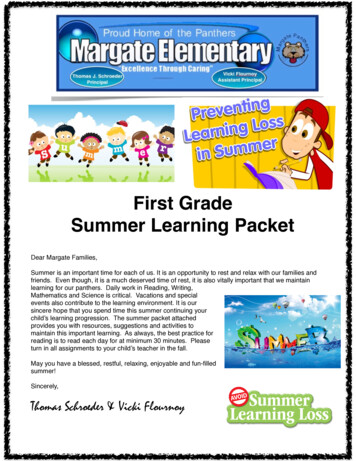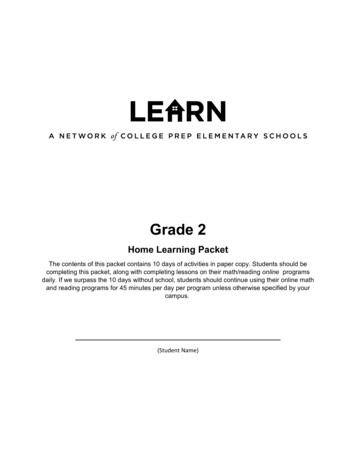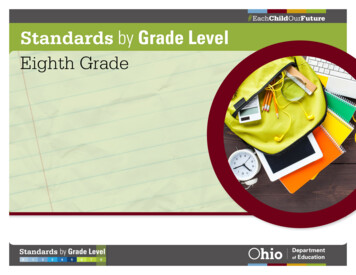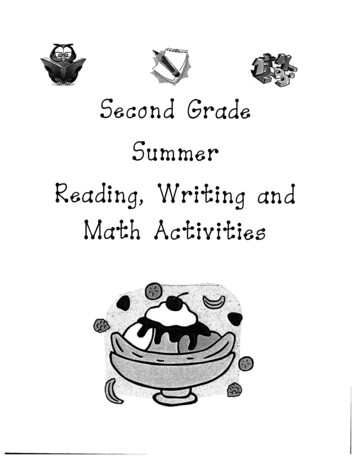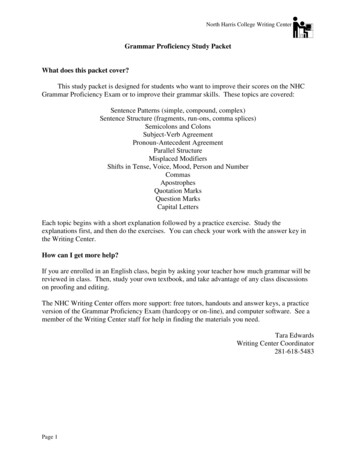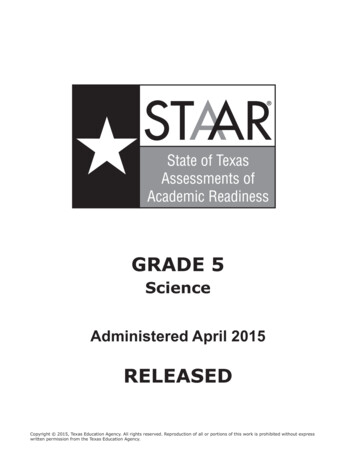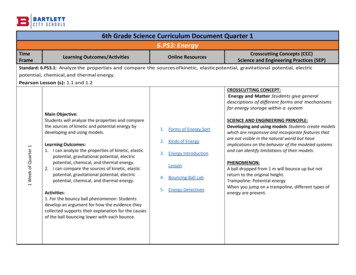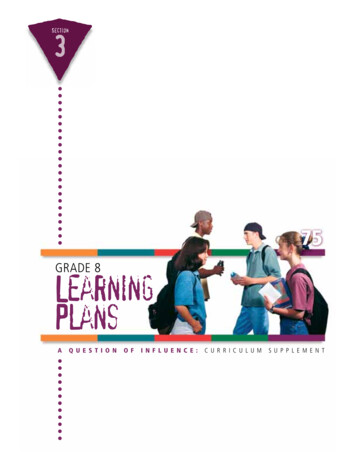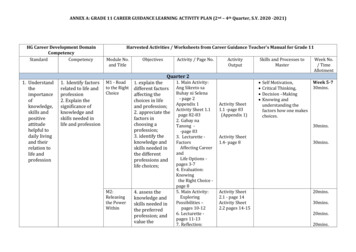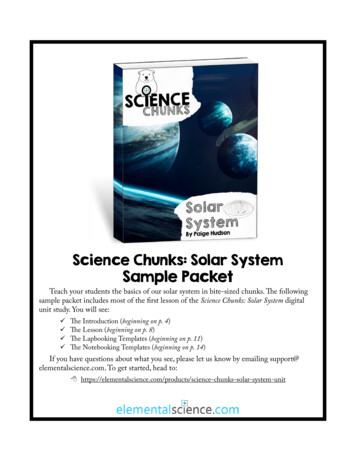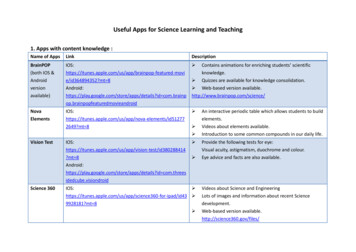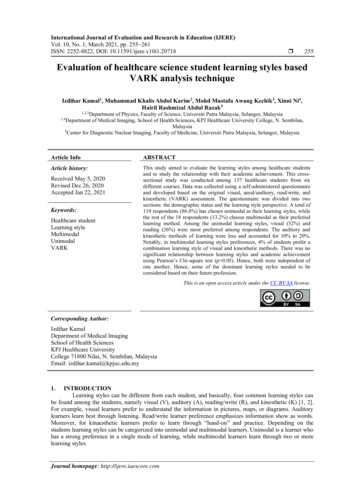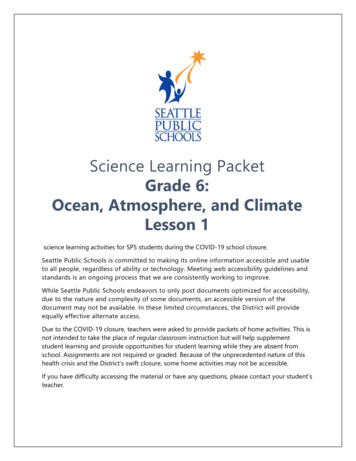
Transcription
Science Learning PacketGrade 6:Ocean, Atmosphere, and ClimateLesson 1science learning activities for SPS students during the COVID-19 school closure.Seattle Public Schools is committed to making its online information accessible and usableto all people, regardless of ability or technology. Meeting web accessibility guidelines andstandards is an ongoing process that we are consistently working to improve.While Seattle Public Schools endeavors to only post documents optimized for accessibility,due to the nature and complexity of some documents, an accessible version of thedocument may not be available. In these limited circumstances, the District will provideequally effective alternate access.Due to the COVID-19 closure, teachers were asked to provide packets of home activities. This isnot intended to take the place of regular classroom instruction but will help supplementstudent learning and provide opportunities for student learning while they are absent fromschool. Assignments are not required or graded. Because of the unprecedented nature of thishealth crisis and the District’s swift closure, some home activities may not be accessible.If you have difficulty accessing the material or have any questions, please contact your student’steacher.
Grade 6 Science Learning ActivityOcean, Atmosphere, & Climate UnitLessons 1 Instructional MaterialsAir Temperature1SPS Science, 3-2020
Hello Families,We hope you and your family are well and safe during this time. During this unprecedented out-of-schooltime, the SPS middle school science team will be offering instructional opportunities for students that alignwith the district’s adopted middle school science instructional materials. This work is optional and nongraded.This investigation packet is the first part in a series of district-aligned lessons about Oceans, Atmosphere, &Climate, a 6th grade life science unit developed by AmplifyScience. While Amplify Science lessons aredesigned to be done in the classroom with peers, there are some activities that students can complete athome. In this packet you will find activities to accompany lessons 1 and 2 of the unit. Accompanying lessonvideos will be aired on SPS TV and posted the SPS webpage under Grade 7, however this packet can be usedwith or without the accompanying video.The videos can be accessed either online or through Seattle’s Public television programming on SPS TV (localchannel 26), social media (Facebook and Instagram: @SeattlePublicSchools, Twitter: @SeaPubSchools), andour SPSTV YouTube channel. KOMONews.com will also host on-demand videos under the tab “Lesson Plan”and broadcast on channel KOMO 4.3. These supplemental learning videos feature short segments supporting avariety of subjects and grade levels. All videos will be close captioned on YouTube. For more informationregarding the SPS TV broadcast schedule and to find the videos, please visit the following /media operations center sps-tv/broadcast scheduleFor students who have access to the internet and the following devices and browsers may wish to log-in totheir AmplifyScience account from home are welcome to do so. See below for guidance on which browser Desktops and Laptops (Windows 7 , Mac OS 10.11 ) - Suggested browsers: Chrome & Safari Chromebooks - Suggested browser: Chrome iPads that support iOS11.3 (iPad5 ) - Suggested browser: SafariSincerely,Seattle Public Schools Science Department2SPS Science, 3-2020
Lesson 1Climate and Climate Scientists:You can probably think of a place on Earth that is usually very warm or a place thatis usually very cold. Have you ever thought about what determines the airtemperature of a place? This is what we will focus on in the Ocean, Atmosphere,and Climate unit.Scientists that study the earth’s climate are called climatologists. They also studyrecurring conditions that affect weather and people all over the world insignificant ways. You will learn about climatologists collect data and what thesescientists are looking for when they analyze the data.Climate: General weather patterns over a long period of timeWhat do climatologists do?Climatologists study temperature and weather patterns over time.Instead of trying to explain why the temperature today is different from the temperatureyesterday, a climate scientist might try to explain why the average temperature this year iswarmer or cooler than last year. For example, a climate scientist would investigate a location’saverage temperature over a long time, not the temperature on one particular day.Climate scientists expect a particular location's climate to stay the same. When they makeobservations that are out of the ordinary for a place’s climate, like a particularly high or lowtemperature over a period of time for that place, they carefully consider what the data mightmean.In this lesson, you will meet climate scientists who are researching El Niño, a topic you will bestudying throughout the unit. You will be asked to take on the role of a climate scientist whosejob it is to determine why Christchurch, a city in the country of New Zealand, has a lower airtemperature (the air temperature cooler than usual) during El Niño years and share ideasabout possible causes. If you have access to the Oceans, Atmosphere, Climate video lesson Part1on SPS TV or on the internet through Amplify, watch the Chasing El Niño video now.3SPS Science, 3-2020
Unit Question: During El Nino years, why is Christchurch, NewZealand’s temperature cooler than usual?Location ofChristchurch, NewZealand in thesouthern PacificOcean4SPS Science, 3-2020
What Determines the Air Temperature of a Location?What is Surface Temperature? In this unit we'll be investigating surface temperature, which isthe air right above the surface, not the air higher up in the atmosphere. When we talk aboutChristchurch’s air temperature we are talking about the surface temperature - the air directlyabove Christchurch. Many things have a surface—tables, chairs, desks, and so forth, but whenwe refer to Earth’s surface, we’re talking about land and waterAtmosphere: Climatologists use the term atmosphere to describe the mixture of gases or airthat surround a planet.During El Nino years, why is Christchurch, New Zealand’stemperature cooler than usual? Claim 1: The amount of incoming energy from the sun changes Claim 2: Something about Earth’s surface (land or water) changes Claim 3: Something about the air changesWhich claim do you think best answers the question about why the temperature inChristchurch, New Zealand is cooler than usual? Tell us why you agree with this claim.5SPS Science, 3-2020
Exploring Temperature and Energy in the Ocean, Atmosphere, and Climate SimulationSince Christchurch,New Zealand’stemperature changesduring El Niño years,you will first need tofigure out what cancause a temperaturechange. You will usethe computerSimulation todetermine how tochange airtemperature. If youhave access tointernet and can log-in to your Amplify Science account, please open the OAC SIM now.6SPS Science, 3-2020
Collecting evidence from the sim to answer our unit question1. In what ways can you make the air temperature change in the Sim? I would (add / remove) energy to make the temperature increase. (circleone)2. In what ways can you make the air temperature decrease? I would (add / remove) energy to make the temperature decrease? (circleone)3. Where does the energy in the air and water come from?ENERGY: the ability to make things move or changeTEMPERATURE: a measure of how hot or cold something is; a measure of the averagekinetic energy of the molecules of a thingReading: “Effects of El Niñ o Around the World”Read Chapter 1: Different Places, Different Effects as an introduction to El Niño. Then choose asecond of the next three chapters to read to learn about the effects of El Niño in a specificlocation. Annotate the article using the Active Reading strategies that work best for you andthen answer the questions.Optional challenge: When you are finished, choose another chapter to learn about the effectsof El Niño in a different location.Active Reading StrategiesUse red pencil (or other color:) to underline evidenceUse green pencil (or other color:) to circle unit glossary words and unfamiliar wordsWrite definitions above circled wordsWrite in the margins to identify questions, impactful ideas, and “a-ha!” moments7SPS Science, 3-2020
Chapter 1: Different Places, Different EffectsDifferent places on Earth have their own weatherpatterns that depend on things like local geographyand distance from the equator. These weatherpatterns are known as regional climates, and theydon’t change very much from year to year . . .ordinarily. However, an El Niño year is anything butordinary! The climate pattern called El Niño happensevery 2 to 7 years, bringing important changes intemperature, precipitation, and more. El Niñoaffects the whole planet, but it has different effectson different locations. Choose one of the chaptersthat follow to learn more about the effects of ElNiño on the regional climate in a particular place onthe globe.The climate pattern called El Niñocauses wet weather in some placesand extreme drought in others.8SPS Science, 3-2020
Chapter 2: Drought in PakistanLate summer and early fall are usually wet times in the country of Pakistan. Normally, themonsoon season in August and September brings heavy rainstorms. Monsoon season suppliesabout half of Pakistan’s rain for a typical year—about 25 centimeters (16 inches) in just twomonths. These storms keep temperatures from getting too hot. However, the climate patterncalled El Niño weakens the monsoon season in Pakistan, causing dry, hot weather instead ofcool rain. This unusual weather causes a variety of health problems for people there and keepscrops from being watered. Without water to grow food, many people’s health problems getworse because they don’t get the nutrition they need to get well.In Pakistan, the El Niño climate pattern causes hot, dry weatherinstead of monsoon storms.9SPS Science, 3-2020
Chapter 3: Landslides in Los AngelesNormally, Southern California is a prettydry place: the city of Los Angeles only getsabout 38 centimeters (15 inches) of raineach year. During El Niño years, however,Los Angeles can get much more rain thanusual. For such a dry place, the extra rainbrought by El Niño may sound like a goodthing—but it can be dangerous. Largeamounts of rain falling on dry, hilly groundwithout many plants to keep the dirt inplace can lead to landslides. In Los Angeles,some people build homes at the tops ofhills. These hilltop homes can be destroyedwhen the dirt underneath them gets toowet and slides downhill. Landslides can alsoblock or destroy roads, injuring people intheir paths and causing millions of dollarsin damage.Extra rain in Los Angeles might sound like agood thing, but it can cause landslides thatdestroy homes and block roads.10SPS Science, 3-2020
Chapter 4: Malaria in ColombiaIn the South American country of Colombia, El Niño causes serious droughts. Thesedroughts can affect farmers in the area, but they have an even bigger effect on public healththere. During El Niño years, Colombia has a 17% increase in cases of a serious disease calledmalaria. When rivers and streams begin to dry up in a drought, the remaining water formsmany shallow pools that are good places for mosquitoes to live and breed. Mosquitoes carrymalaria, transmitting it to people by biting them. More places for mosquitoes to breed meansthere are more mosquitoes around to transmit malaria to nearby humans. Mosquitoestypically breed faster in warm weather, so rising temperatures may also work to increase therates of malaria in Colombia during El Niño years.When rivers and streams begin to dry up, they form pools where mosquitoeslive and breed. These mosquitoes can carry malaria and transmit it to peopleliving nearby.11SPS Science, 3-2020
Reading Reflection: : “Effects of El Niñ o Around the World”1. Which article did you read? (circle one)o “Drought in Pakistan”o “Landslide in Los Angeles”o “Malaria in Colombia”2. Why do you think it is important for climate scientists to study El Niño?12SPS Science, 3-2020
and broadcast on channel KOMO 4.3. These supplemental learning videos feature short segments supporting a variety of subjects and grade levels. All videos will be close captioned on YouTube. For more information regarding the SPS TV broadcast schedule an
